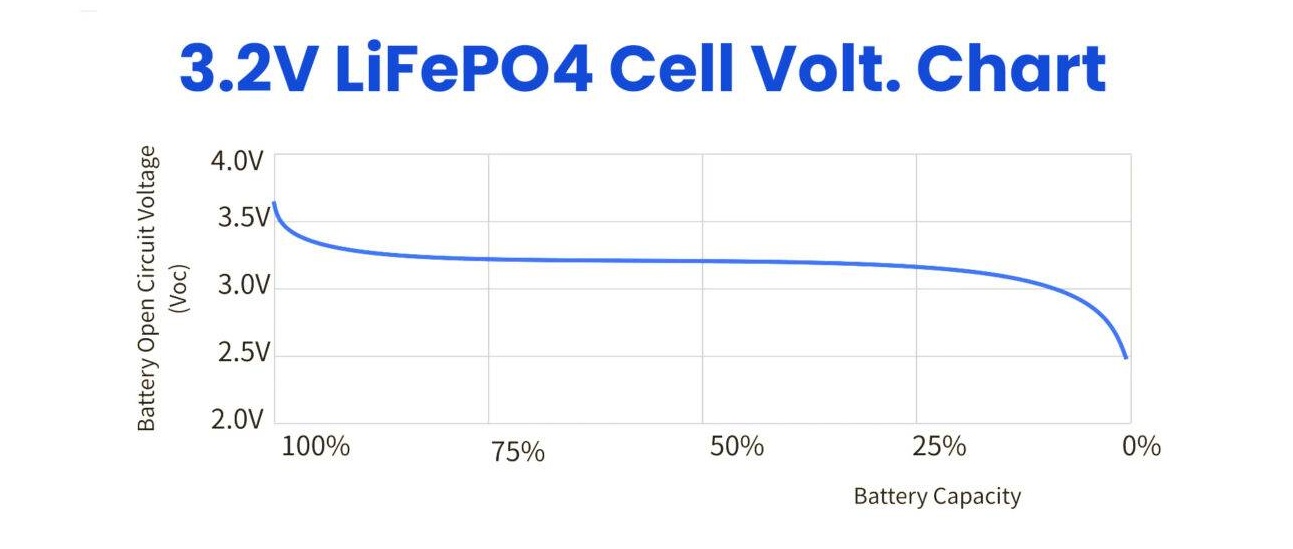Blog
LiFePO4 Battery Voltage Chart: What Every User Should Know
2025-05-22 | Eric

🔋 Introduction: Why LiFePO4 Battery Voltage Matters
Lithium iron phosphate (LiFePO4) batteries are rapidly becoming the go-to power solution for solar energy systems, RVs, marine setups, and off-grid applications. Renowned for their safety, long cycle life, and thermal stability, LiFePO4 batteries also offer remarkably consistent voltage output, which makes them ideal for both residential and commercial energy storage systems.
However, to get the most out of a LiFePO4 battery—whether it’s a 3.2V cell or a 48V pack—you need to understand how its voltage correlates with State of Charge (SOC), charging behavior, efficiency, and overall battery health.
In this article, we’ll walk you through a detailed LiFePO4 voltage chart, explain the science behind it, and offer practical advice on charging and maintenance.
📊 LiFePO4 Voltage Chart by Battery System
Here’s a quick reference chart showing typical voltage ranges for LiFePO4 batteries of different configurations at various charge stages:
| Percentage (SOC) | 3.2V Cell | 12V (4S) | 24V (8S) | 48V (16S) |
|---|---|---|---|---|
| 100% Charging | 3.65V | 14.6V | 29.2V | 58.4V |
| 100% Rest | 3.40V | 13.6V | 27.2V | 54.4V |
| 90% | 3.35V | 13.4V | 26.8V | 53.6V |
| 80% | 3.32V | 13.3V | 26.6V | 53.1V |
| 70% | 3.30V | 13.2V | 26.4V | 52.8V |
| 60% | 3.27V | 13.1V | 26.1V | 52.3V |
| 50% | 3.26V | 13.0V | 26.1V | 52.2V |
| 40% | 3.25V | 13.0V | 26.0V | 52.0V |
| 30% | 3.22V | 12.9V | 25.8V | 51.5V |
| 20% | 3.20V | 12.8V | 25.6V | 51.2V |
| 10% | 3.00V | 12.0V | 24.0V | 48.0V |
| 0% | 2.50V | 10.0V | 20.0V | 40.0V |
🔍 Note: These values are approximate and can vary slightly depending on battery brand, ambient temperature, and load conditions.
⚙️ How Voltage Affects LiFePO4 Battery Performance
Voltage isn’t just a number on your battery monitor—it’s a direct indicator of performance, lifespan, and efficiency. Here’s why it matters:
✅ 1. Capacity & Power Output
Higher voltage typically allows a battery to deliver more power. For example, a 24V or 48V system reduces current draw, making it more efficient and better for high-load devices like inverters and motors.
✅ 2. Charging Behavior
- Optimal charging voltage for a LiFePO4 cell is 3.50–3.65V.
- Overcharging above 3.65V can degrade the battery.
- Undercharging below 3.2V reduces capacity.
Using a LiFePO4-specific charger is essential to prevent damage and ensure full charge without overvoltage.
✅ 3. Discharging
Discharging below 2.5V per cell (or 10V in a 12V system) can cause irreversible chemical damage to the battery. Always use a Battery Management System (BMS) or low-voltage cut-off protection.
✅ 4. Efficiency
LiFePO4 batteries maintain a flat voltage curve, meaning consistent power output during most of the discharge cycle. This improves device efficiency and runtime, especially under heavy loads.
✅ 5. Lifespan
Proper voltage regulation can give you 3000–5000 cycles, far more than lead-acid batteries. Avoid deep discharges and high-voltage overcharging to preserve longevity.
⚡ Bulk, Float & Equalize Voltages for LiFePO4 Batteries
Different charging stages require different voltage limits. Here's a breakdown:
| Charging Stage | 3.2V Cell | 12V System | 24V System | 48V System |
|---|---|---|---|---|
| Bulk | 3.65V | 14.6V | 29.2V | 58.4V |
| Float | 3.375V | 13.5V | 27.0V | 54.0V |
| Equalize | 3.65V | 14.6V | 29.2V | 58.4V |
⚠️ Important: Unlike lead-acid batteries, LiFePO4 does not need equalization charging. If your charger includes this feature, disable it unless it’s LiFePO4-compatible.
🔌 Recommended Charging Parameters
| Parameter | 3.2V | 12V | 24V | 48V |
|---|---|---|---|---|
| Charging Voltage | 3.5–3.65V | 14.2–14.6V | 28.4–29.2V | 56.8–58.4V |
| Float Voltage | 3.2V | 13.6V | 27.2V | 54.4V |
| Max Voltage (Safe) | 3.65V | 14.6V | 29.2V | 58.4V |
| Min Voltage (Cutoff) | 2.5V | 10V | 20V | 40V |
| Nominal Voltage | 3.2V | 12.8V | 25.6V | 51.2V |
Always match your charger to the voltage range of your battery. Mismatched chargers can lead to reduced performance or permanent damage.
🛠️ Real-World Application Tips
- Solar Systems: Use a solar charge controller with LiFePO4 profiles. MPPT controllers are best for efficiency.
- RVs/Marine: 12V LiFePO4 batteries are a lightweight, long-lasting replacement for lead-acid.
- Backup Systems: 48V batteries offer reduced current for high-power applications, making wiring and inverters more efficient.
🧠 Conclusion: Use Voltage Wisely, Extend Battery Life
Understanding and monitoring the LiFePO4 voltage range is key to battery health and system reliability. Whether you're a DIYer building a solar generator or a professional managing an off-grid setup, following voltage guidelines helps you:
- Maximize usable capacity
- Prevent damage and ensure safety
- Extend your battery's lifespan
🔖 FAQ (for SEO & UX enhancement)
Q: What is the fully charged voltage of a LiFePO4 12V battery?
A: 14.6V is typically the full-charge voltage for a 12V LiFePO4 battery.
Q: Can I use a lead-acid charger for LiFePO4?
A: Not recommended. Lead-acid chargers may overcharge or undercharge LiFePO4 batteries, reducing performance and safety.
Q: What happens if I over-discharge my LiFePO4 battery?
A: Discharging below 2.5V per cell can cause irreversible damage and significantly reduce battery lifespan.
Popular Articles
Contact Details
Worktime :Monday to Friday 9am - 6pm (HKT)
WhatsApp/Wechat/Mobile :+86XXXXX
Email : info@lifepo4cellstore.com
